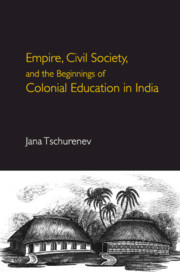Book contents
- Frontmatter
- Dedication
- Contents
- List of Figures
- List of Tables
- List of Abbreviations
- Acknowledgements
- Introduction: Empire Civil Society, and Educational Transformation in India
- 1 A Colonial Experiment in Education, Madras, 1789–1796
- 2 Education of the Poor, 1805–1813
- 3 Missionaries, Empire, and the Cause of Universal Education, 1792–1824
- 4 Race, Class, and Gender: The Social Agenda of Education, 1809–1830
- 5 Rules and Numbers: Transforming Rural Education, 1814–1830
- 6 Intellectual Conquest: Education Societies, ‘Useful Knowledge’, and the Bengal Renaissance, 1817–1854
- 7 Civil Society, Government, and Educational Institution-Building, Bombay Presidency, 1819–1882
- 8 Teaching the Marginalized: Universal Education and the Politics of Inequality, 1789–1937
- Conclusion: The Emergence of Public Elementary Schooling in an Imperial Frame
- Bibliography
- Index
Conclusion: The Emergence of Public Elementary Schooling in an Imperial Frame
Published online by Cambridge University Press: 26 April 2019
- Frontmatter
- Dedication
- Contents
- List of Figures
- List of Tables
- List of Abbreviations
- Acknowledgements
- Introduction: Empire Civil Society, and Educational Transformation in India
- 1 A Colonial Experiment in Education, Madras, 1789–1796
- 2 Education of the Poor, 1805–1813
- 3 Missionaries, Empire, and the Cause of Universal Education, 1792–1824
- 4 Race, Class, and Gender: The Social Agenda of Education, 1809–1830
- 5 Rules and Numbers: Transforming Rural Education, 1814–1830
- 6 Intellectual Conquest: Education Societies, ‘Useful Knowledge’, and the Bengal Renaissance, 1817–1854
- 7 Civil Society, Government, and Educational Institution-Building, Bombay Presidency, 1819–1882
- 8 Teaching the Marginalized: Universal Education and the Politics of Inequality, 1789–1937
- Conclusion: The Emergence of Public Elementary Schooling in an Imperial Frame
- Bibliography
- Index
Summary
In the early nineteenth century, a diverse imperial civil society movement set out to expand and reform Indian education. This included British, German, and American missionaries, and non-governmental, non-profit organizations dedicated to the ‘cause of universal education’, operating from Britain and in the colonial urban centres (Chapter 3). Together, they triggered a process by which the prevalent, indigenous Indian educational landscape was, slowly and unevenly, substituted by the colonial governmental education system. I have explored this transformation for the elementary level of education, directed not at the social and cultural elites, but at the common people.
This transformation entailed, first, a fundamental change in the culture of schooling (Chapter 5). Locally grown forms of pedagogy, learning, and discipline were substituted by standardized teaching technologies in formal institutional settings. School time, and school space were reorganized. Personal student–teacher relationships became embedded in impersonal frameworks of evaluating and measuring success. Examinations, paperwork, and elaborate reporting came to frame the teaching–learning arrangements.
Second, colonial schools changed the curricular content, based on new educational media (Chapter 6). The textbook became the centre of teaching– learning processes. It contained the knowledge that the teacher, trained in the usage of such materials and the school-management techniques, was expected to impart. Standardizing curricula, on the one hand, enabled education reformers (initially missionaries and civil society organizations, later government agencies) to define what was worth teaching. What was it that all children needed to know or be able to perform? On the other hand, it allowed for an easy assessment, comparison, and reward of the students’ progress and the teachers’ work. Building on the experiments of the local missionaries (William Carey, Joshua Marshman, Robert May, and J.D. Pearson), the Calcutta School Book Society (CSBS) and the Calcutta School Society (CSS) defined a standard course of vernacular elementary instruction that all schools under their control were expected to impart. This included literacy and language instruction, arithmetic and accounts, secular moral instruction, and the basics of geography, modern science, and history. Vernacular languages were orthographically standardized, translated into printed characters, and culturally refined according to new middle-class norms of social respectability.
- Type
- Chapter
- Information
- Publisher: Cambridge University PressPrint publication year: 2019



